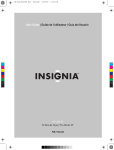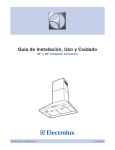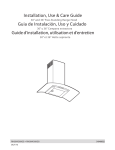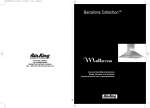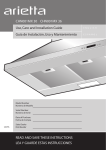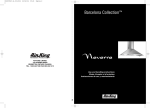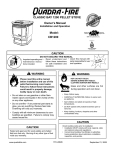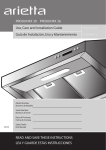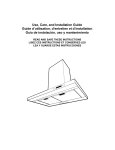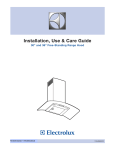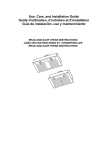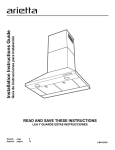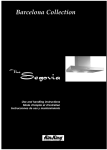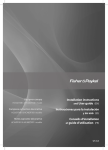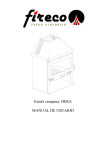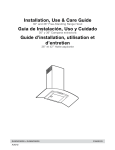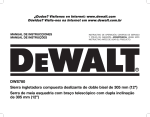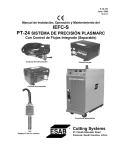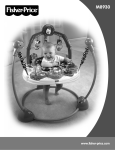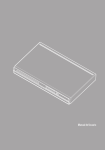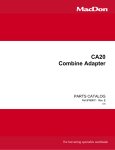Download Arietta Dekor Glass 30 Instructions / Assembly
Transcript
Guía de instalación, uso y mantenimiento. Use, Care, and Installation Guide Dekor Glass 30" - 36" Model number: Número de modelo:________________________________________ Serial number: Número de serie:_______________ ________________________ Date of Purchase: Fecha de compra: _____________________________________ Sales Dealer: Distribuidorr: _____________________________________ READ AND SAVE THESE INSTRUCTIONS LEA Y GUARDE ESTAS INSTRUCCIONES LI2YRB English Spanish page page 2 34 APPROVED FOR RESIDENTIAL APPLIANCES FOR RESIDENTIAL USE ONLY READ AND SAVE THESE INSTRUCTIONS PLEASE READ ENTIRE INSTRUCTIONS BEFORE PROCEEDING. INSTALLATION MUST COMPLY WITH ALL LOCAL CODES. IMPORTANT: Save these Instructions for the Local Electrical Inspector’s use. INSTALLER: Please leave these Instructions with this unit for the owner. OWNER: Please retain these instructions for future reference. Safety Warning: Turn off power circuit at service panel and lock out panel before wiring this appliance. Requirement: 120 VAC, 60 Hz. 15 or 20 A Branch Circuit 2 Electrical & Installation Requirements ............................................ 7 Electrical requirements .............................................................. 7 Before installing the hood ........................................................... 7 List of Materials ................................................................................. 8 Parts included in your hood ....................................................... 8 Optional accessories ................................................................. 8 Materials required ...................................................................... 8 Tools required for installation ...................................................... 8 Product Dimensions and Clearances ............................................... 9 Installation Instructions .............................................................. 10-22 Installing preparation ................................................................ 10 Removing the packaging .......................................................... 12 Ductwork and wiring locations ................................................. 14 Mounting the duct cover bracket .............................................. 15 Option A - Fixed heigh duct cover ............................................ 15 Option B- Telescopic duct cover .............................................. 16 Ceiling ducting ......................................................................... 17 Wall ducting ............................................................................ 17 House wiring location ............................................................... 17 Installing framing for hood support............................................ 18 Mounting the hood ................................................................... 18 Connecting the ductwork ......................................................... 20 Making the electrical connections............................................ 20 Mounting the glass canopy ...................................................... 21 Mounting the duct cover ........................................................... 22 3 Table of Contents Important Safety Notice ................................................................. 5-6 Table of Contents Use And Care Instructions .......................................................... 23-28 Control and feature ................................................................... 24 Special Functions .................................................................... 25 Clock programming .................................................................. 25 Grease filter saturation alarm ................................................... 25 Charcoal filter saturation alarm (Recirculating accessories) ...... 26 Audible signal activation and deactivation ................................. 26 Charcoal filter inclusion and exclusion (Recirc.accessories) ..... 26 Heat sensor ............................................................................. 26 Metal grease filter maintenance ................................................ 27 Hood maintenance ................................................................... 28 Lamp bulb maintenance ........................................................... 28 Available Accessories ................................................................ 29-30 Charcoal filter placement (Recirculating accessories) ............... 29 Non-return valve installation (Recirculating accessories) .......... 29 Air deflector installation (Recirculating accessories) ................ 30 Telescopic duct cover Kit ......................................................... 30 Trouble Shooting ............................................................................. 31 List of Parts and Accessories .......................................................... 32 Warranty ........................................................................................... 33 4 CAUTION: FOR GENERAL VENTILATING USE ONLY. DO NOT USE TO EXHAUST HAZARDOUS MATERIALS, EXPLOSIVE MATERIALS OR VAPORS. CAUTION: DURING THE HOOD INSTALLATION, THE PEOPLE INSTALLING THE HOOD MUST WEAR PROTECTION GLOVES AGAINTS SHARP EDGES. WARNING TO REDUCE THE RISK OF FIRE, ELECTRIC SHOCK OR INJURY TO PERSONS, OBSERVE THE FOLLOWING: • Use this unit only in the manner intended by the manufacturer. If you have questions, contact the manufacturer. • Before servicing or cleaning the unit, switch power off at the service panel and lock service panel to prevent power from being switched ON accidentally. If the service panel cannot be locked, fasten a tag or prominent warning label to the panel. • Installation work and electrical wiring must be done by qualified person(s) in accordance with all applicable codes & standards, including Fire-rated construction. • Sufficient air is needed for proper combustion and exhausting of gases through the flue (chimney) of fuel burning equipment to prevent back- drafting. Follow the heating equipment manufacturers guideline and safety standards such as those published by the National Fire Protection Association (NFPA), the American Society for Heating, Refrigeration and Air Conditioning Engineers (ASHRAE), and the local code authorities. • When cutting or drilling into wall or ceiling, do not damage electrical wiring and other hidden utilities. • Ducted systems must always be vented to the outdoors. • Do not make alterations to the original wiring. • Do not attempt to repair or replace any part of your hood unless it is specifically recommended in this manual. All other servicing should be referred to a qualified technician. • Avoid using food products that produce flames under the range hood. • This unit must be grounded. CAUTION: To reduce risk of fire and to properly exhaust air, be sure to duct air outside - do not vent exhaust air into spaces within walls, ceilings, attics, crawl spaces, or garages. Automatically operated device - to reduce risk of injury disconnect from power supply before servicing. WARNING TO REDUCE THE RISK OF FIRE, USE ONLY METAL DUCT WORK. Install this hood in accordance with all requirements specified. WARNING TO REDUCE THE RISK OF FIRE OR ELECTRIC SHOCK, DO NOT USE THIS HOOD WITH ANY EXTERNAL SOLIDSTATE SPEED CONTROL DEVICE. 5 Important Safety Notice READ AND SAVE THESE INSTRUCTIONS Important Safety Notice WARNING TO REDUCE THE RISK OF A RANGE TOP GREASE FIRE. • Never leave surface units unattended at high settings. Boilovers cause smoking and greasy spill over that may ignite. Heat oils slowly on low or medium settings. • Always turn hood ON when cooking at high heat or when flambeing food (i.e. Crepes Suzette, Cherries Jubilee, Peppercorn Beef Flambe’). • Clean filters frequently. Grease should not be allowed to accumulate on filters. • Use proper pan size. Always use cookware appropriate for the size of the surface element. WARNING TO REDUCE THE RISK OF INJURY TO PERSONS, IN THE EVENT OF A RANGE TOP GREASE FIRE, OBSERVE THE FOLLOWING “a”: • • • • SMOTHER FLAMES with a close-fitting lid, cookie sheet, or other metal tray, then turn off the gas burner or the electric element. BE CAREFUL TO PREVENT BURNS. If the flames do not go out immediately, EVACUATE AND CALL THE FIRE DEPARTMENT. NEVER PICK UP A FLAMING PAN - you may be burned. DO NOT USE WATER, including wet dishcloths or towels -a violent steam explosion will result. Use an extinguisher ONLY if: a) You know you have a class ABC extinguisher, and you already know how to operate it. b) The fire is small and contained in the area where it started. c) The fire department is being called. d) You can fight the fire with your back to an exit. “a” Based on "Kitchen Fire Safety Tips" published by NFPA. Note To Installer Be sure to leave these instructions to the customer. Note To The Customer • • Keep this instruction manual for future reference. Keep this instruction manual for local inspector. Operation Always leave safety grills and filters in place. Without these components, operating blowers could catch onto hair, fingers and loose clothing. The manufacturer declines all responsibility in the event of failure to observe the instructions given here for installation, maintenance and suitable use of the product. The manufacturer further declines all responsibility for injury due to negligence and the warranty of the unit automatically expires due to improper maintenance. 6 IMPORTANT: • • • • • • • • • • • Observe all governing codes and ordinances. It is the customer’s responsibility: o To contact a qualified electrical installer. o To assure that the electrical installation is adequate and in conformance with National Electrical Code, ANSI/NFPA70 — latest edition* and all local codes and ordinances. If codes permit and a separate ground wire is used, it is recommended that a qualified electrician determine that the ground path is adequate. Do not ground to a gas pipe. Check with a qualified electrician if you are not sure that the range hood is properly grounded. Do not have a fuse in the neutral or ground circuit. Save installation instructions for electrical inspector’s use. The range hood must be connected with copper wire only. The range hood should be connected directly to the fused disconnect (or circuit breaker) box through metal electrical conduit. Wire sizes must conform to the requirements of the National Electrical Code ANSI/NFPA 70 — latest edition* and all local codes and ordinances. U.L. (underwritters Laboratories) listed conduit connector must be provided at each end of the power supply conduit (at the range hood and at the junction box). * Copies of the standards listed may be obtained from: National Fire Protection Association Batterymarch Park Quincy, Massachusetts 02269 Electric requirements • These vent hoods must be power supplied 120 V, 60 Hz, and connected to an individual, properly grounded branch circuit, and protected by 15 or 20 Amps circuit breaker or fuse. • • • • Wiring must be two wire with ground. If the electrical supply does not meet above requirements, call a licensed electrician before proceeding. Route house wiring as close to the installation location as possible, in the ceiling or back wall. The hood must be connected to the house wiring in accordance with the local codes. CAUTION: This appliance should be properly grounded. Before installing the hood • • • • • • • For the most efficient air flow exhaust, use a straight run or as few elbows as possible. CAUTION: Vent unit to outside of building only. At least two people are needed for installation. On average one to three hours are necessary to complete installation (without considering cut to be done on wall and/or on cabinet, installation ducts, conduit and electrical connections to the mains). The hood is fitted with screws and concrete anchors suitable for most surfaces, consult a qualified installer, check if they perfectly fit with your cabinet/wall. Do not use flex ducting. COLD WEATHER installations should have an additional non return valve (Accessory not provided with the hood) installed to minimize backward cold airflow and a nonmetallic thermal break to minimize conduction of outside temperatures as part of the duct work. Makeup air local building codes may require the use of makeup air systems when using ducted ventilation systems greater than specified CFM of air movement. Consult your HVAC professional for specific requirements in your area. 7 Electrical & Installation Requirements ELECTRICAL REQUIREMENTS List of Materials Parts included in your hood • • • • • • Hood canopy assembly with blower, transition. Lamp already installed. Grease filter. Glass Canopy Duct cover. Hardware bag with: o Plastic Gasket. o Template. o Duct cover support bracket (1 piece) o Use, care and installation guide o Glass bracket (2 pieces) o Wood screws (6 pieces - 3/16" x 1" 3/4) o Hood attachment anchors screws (6 pieces - 1/8" x 3/8") o Assembly screws (8 pieces) Optional accessories • • • Telescopic duct cover to fit ceiling height from 8' to 10' Re circulation KIT Non return valve Materials required • • • • Duct tape Wire nuts Tape to mount template 6" rounded metal duct length to suit installation Tools required for installation • • • • • • • • • • • • Gloves to protect against sharp edges Safety glasses Hammer Electric drill with 5/16" bit Pliers Measuring tape Saw, jig saw Level Knife Wire cutter Phillips (Pozidrive) # 2 screwdriver Torx # 2 screwdriver 8 DUCT COVER BRACKET 28-22/32" 17-3/16" 20" 30" or 36" The vent hood must be installed above the cooking surface at 30" if a gas range is used or from 24" to 30" if an electric range is used. If the customer needs that the duct cover reaches from 8' to 10' ceilings height, then an additional telescopic duct cover accessory is needed. 9 Product Dimensions and Clearances 13 1/8" Installation Instructions Installation height: 30" gas cooktop/range or 24" to 30" electric cooktop/range. The hood may be installed onto a wall and vented to the outdoors, or it can be installed for recirculating operation (recirculating accessories not supplied with the hood). This hood can be installed over any electric and gas cooktop/range. It can not be installed over any professional cooktop / range. Installing preparation Advance planning • Determine the exact location of the vent hood. • Plan the route for venting exhaust to the outdoors. • Use the shortest and straightest duct route possible. For satisfactory performance duct run should not exceed 100’ equivalent length for any duct configurations. • Refer to “Duct Fittings” chart to compute the maximum permissible length for duct runs to the outdoors. • Install a wall cap with damper or roof cap at the exterior opening. Order the wall or roof cap and any transition needed in advance. • Use 6" round metal ductwork only. Wall framing for adequate support • This vent hood is heavy. Adequate structure and support must be provided in all types of installations. The hood must be secure to vertical studs in the wall, or to a horizontal support. • The vent hood should be on site before final framing and wall finishing. This will help to accurately locate the duct work and electrical service. • Installation will be easier if the vent hood is installed before the cook-top and countertop are installed. 10 6” 6” 6” 6” 6” 11 Installation Instructions 6” 6” 6” 6” 6” Installation Instructions Removing the packaging CAUTION: Wear gloves to protect against sharp edges. First remove the carton carefully and take out the duct cover. CAUTION: Remove carefully the glass canopy from the box and put it on a smooth safe surfaces. Grasp the hood structure from the body and lift straight off the box. Remove and properly discard every carton and plastic wrapping content in the package. Remove parts out of the box, duct covers and other contents. 12 DUCTLESS CONVERSION KIT Accessory not included in the hood Locate the hardware accesories box packed with the hood charcoal filter Air deflector 4 springs 6 wall fasteners 8 assembly screws TELESCOPIC DUCT COVER KIT Accessory not included in the hood 13-3/16" 6 wood screws From 32 3/32" To 52 14/16" 2 Glass braket Plastic gasket 10-14/16" duct cover (dimension shown for reference only) Vertical centerline REAR WALL MOUNTING TEMPLATE ALIGN BOTTOM EDGE WITH PENCIL LINE INDICATING BOTTOM OF THE HOOD Duct cover support bracket Installation height Horizontal line Wall mount template 13 Installation Instructions CHECK INSTALLATION HARDWARE Installation Instructions Ductwork and wiring locations • Determine the exact location of the vent hood. • Locate the template packed with the literature. • The height installation is determined by the following image. Mark the location. Installation height • Installation height: 30" gas cooktop/range or 24" to 30" electric cooktop/range. • Use a level to draw a horizontal straight pencil line on the wall, which is your desired installation height. • Find the centerline of the cooktop. Use a level to draw a vertical straight pencil line on the wall. CHECK TO BE SURE THE LINE IS PERFECTLY PERPERNDICULAR. 14 Option A - Fixed heigh duct cover • From the horizontal line traced in the previous section, trace a horizontal parallel line as shown below. • Center the bracket in the top horizontal line and align it with the centerline, as described in the following drawing. Centerline Braket line 27 28/32" Horizontal straight pencil marked line Desired installation height • Mark screw holes locations in the wall. IMPORTANT. Check to be sure that holes locations are leveled, and correctly centered by the vertical centerline. Drill 5/16" pilot holes in the marked locations. Install wall fastener anchors. Drive wood screws, by hand, into the fasteners to allow anchors to expand. Remove screws. Secure the bracket to the wall with wood screws and/or fasteners. 15 Installation Instructions Mounting the duct cover bracket Installation Instructions Option B - Telescopic duct cover The duct bracket should be installed against the back wall and flush with the ceiling. This bracket will hold the duct cover in place at the top (this a extra accessory available not included with the hood). . Secure the bracket to the wall: • Align the marked centerline on the bracket with the centerline on the wall. • Mark 2 screw hole locations in the wall. • Drill 5/16" pilot holes in the marked locations. • Install wall fastener anchors. • Drive wood screws, by hand, into the fastener to allow anchors to expand. Remove the screws. • Secure the bracket to the wall with wood screws and/or fasteners. Ceili ng Wall Vertical centerline 16 If the duct will vent straight up to the ceiling: • Use level to draw a line straight up, from the centerline on the template to the ceiling. • Measure at least 4 -12/16 ” from the back wall to the circle center of an 6-½” hole on the ceiling. Wall ducting If ductwork will vent to rear: • Use a level to draw a line straight up from the centerline on the template. • Measure at least 23 - 12/16" (the measure might vary dependig on the elbow used) above the pencil line that indicates the bottom installation height, to the circle center of an 6-½” diameter duct hole (Hole may be elongated for duct elbow). House wiring location • The junction box is located on the top left side of the hood. • Wiring should enter the back wall at least 20" above the bottom of the installation height, and within 5-7/8" and 4-7/8"of the left side of the centerline. 6 17 Installation instructions Ceiling ducting Installation Instructions Install framing for hood support • • • • If drywall is present, mark the screw hole locations. Remove the template. Cut away enough drywall to expose 2 vertical studs at the holes location indicated by the template. Install two horizontal supports at least 1" X 6" between two wall studs at the bottom mounting holes installation location. The horizontal support must be flush with the room side of the studs. Use cleats behind both sides of the support to secure to wall studs. Reinstall drywall and refinish. IMPORTANT- Framing must be capable of supporting 100 lbs. 6” Mounting the hood WARNING: 2 people are required to lift and position the hood onto the mounting screws. • • • • • • Place the template on the wall along the horizontal line, make sure the template is leveled and centered with the centerline. Mark “upper” screw holes locations in the wall. IMPORTANT. Check to be sure that hole locations are leveled and correctly centered by the vertical centerline. Drive “upper” wood screws by hand. Leave ¼ “ of distance between the screw head and the wall. Mount the hood onto the “upper” screws. Mark “lower” wood screw holes locations in the wall using a pencil. 18 Remove the hood. • Drive “lower” wood screws, by hand. Remove screws. • Mount the hood onto the “upper” screws. • Drive and tight the “upper” wood screws, by hand. • Drive and tight the “lower” wood screws, by hand. • Insert the plastic gasket. 19 Installation Instructions • Installation Instructions Connecting the ductwork • Install ductwork, making connections in the direction of airflow as illustrated. • Push duct over the exhaust outlet. • Wrap all duct joints and the flange connections with duct tape for an airtight seal. • Make the same connection in the wall or ceiling vent exit. Airflow Duct tape over seam Making the electrical connections WARNING: ELECTRICAL SHOCK HAZARD TURN OFF POWER CIRCUIT AT THE SERVICE PANEL BEFORE WIRING THIS UNIT. 120 V, 15 OR 20 AMP CIRCUIT REQUIRED. IF HOUSE WIRING IS NOT A 3 WIRE INSTALLATION (NEUTRAL, LINE AND GROUND), A GROUND MUST BE PROVIDED BY THE INSTALLER. WHEN HOUSE WIRING IS ALUMINUM, BE SURE TO USE U.L. APPROVED ANTI-OXIDANT COMPOUND AND ALUMINUM-TO-COPPER CONNECTORS. ELECTRICAL GROUNDING INSTRUCTIONS THIS APPLIANCE IS FITTED WITH AN ELECTRICAL JUNCTION BOX WITH THREE WIRES, THE WIRE COLOR GREEN / YELLOW SERVES TO GROUND THE APPLIANCE. TO PROTECT YOU AGAINST ELECTRIC SHOCK, THE GREEN/YELLOW WIRE MUST BE CONNECTED TO THE GROUNDING WIRE IN YOUR HOME ELECTRICAL SYSTEM, AND IT MUST UNDER NO CIRCUMSTANCES BE CUT OR REMOVED. FAILURE TO DO SO CAN RESULT IN DEATH OR ELECTRICAL SHOCK. • Remove junction box cover and knockout on the top left side. Knockout Junction box wall cover 20 Secure the metal electrical conduit to the junction box by the UL approved nut. Metal electrical conduit House wiring U.L. listed nut • • Electrical connections: o To connect the “Neutral”, joint by a wire nut the white wire (from the conduit) to the white wire from the junction box. o To connect the “Line”, joint by a wire nut the black wire (from the conduit) to the black wire from the junction box. o To connect the “Ground”, joint by a wire nut the Green/Yellow wire (from the conduit) to the Green/Yellow wire from the junction box. Push wires into junction box. IMPORTANT: Be sure wires are not pinched and / or making contact between the wires. • Secure junction box cover with original screws. Mounting the glass canopy • With the hood mounted on the wall slide the glass canopy over the glass supports. • Insert the glass brackets. • Insert two screws into the bracket holes, drive the screws by hand. 21 Installation Instructions • Installation Instructions Mounting the duct cover • Position the duct cover over the mounted hood. • Slide the bottom of the duct into the glass area. • Position the top of the duct over the duct mounting bracket. If a telescopic duct cover is used, grab the upper part of the telescopic duct cover, pull it and place it in the duct cover mounting bracket. • Secure the top of the duct with 2 assembly screws provided. • Secure the bottom of the duct with 2 assembly screws provided. 22 Before using your hood read this manual carefully. The information on the following pages will help you operate and maintain your Dekor Glass hood properly. Keep it handy to answer your questions. If you receive a damaged hood contact immediately your dealer (builder) that sold you the hood. To obtain service, see the consumer service pages in the back of this manual. First contact the people who serviced your appliance, explain why you are not pleased. In most cases, this will solve the problem. If are not pleased, refer to the warranty page and write all the details including your phone number. 1 Control panel 2 Grease filter 3 Grease filter realese handle 4 Cover lamp 5 Incandescent lamp (position and number of lamps may vary) 6 Duct cover 7 Duct cover hole(s). 8 Glass Canopy 7 6 1 3 8 4 5 2 23 Use And Care Instructions Use and Care Instructions Use And Care Instructions Control and features This hood is equipped with an electronic motor and lamp control. The control is able to set 3 different fan speeds, turn ON/OFF light and has a timer function. In the following drawing are described the main key functions. "TIMER" KEY DISPLAY " "LIGHT" KEY 1. "__" KEY " KEY Timer Key o The default timer setting is 10 minutes, and it can be adjusted between 20 minutes and 1 minute. o After pressing the timer key, the control enters to a timer setup mode, and user can adjust the timer countdown time with the “-” and “+” keys within 5 seconds. The timer can be initiated immediately pressing the timer key, after setting the timer duration or pressing the timer key twice (default 10 minutes setting). o If not action occurs within 5 seconds the countdown will start. o During the timer setup the “-” and “+” keys are dedicated to the timer and no motor action will occur. o 2. 3. Once initiated the timer, it can be cancelled by pressing the timer key again. Light Key o Press lamp key to turn ON the light (Lamp state previously OFF). o Press lamp key to turn OFF the light (Lamp state previously ON). Display Shows the hood settings. 24 5. “-” Key. Speed Decrease / OFF o This key is used to decrease the fan speed, or turn OFF the fan. o The fan will turn OFF if the “-” key is pressed and the hood was in the first speed. o If the fan is at second speed and the “-” key is pressed, the fan will be set to first speed. o If the fan is at third speed and the “-” key is pressed, the fan will be set to second speed. o If the fan is OFF and the “-” key is pressed, the control backlight will light up. “+” Key. Speed Increase / ON o This key is used to increase the fan speed, or turn ON the fan. o The fan will turn ON if the “+” key is pressed and the hood was OFF. o If the fan is at first speed and the “+” key is pressed, the fan will be set to second speed. o If the fan is at second speed and the “+” key is pressed, the fan will be set to third speed. o If the fan is at third speed and the “+” key is pressed, a beep will sound. SPECIAL FUNCTIONS Clock programming • The clock can be reprogrammed at any time except during an active timed function. • The clock can be displayed in a twelve hour format and valid clock times are from 1:00 to 12:59. • The clock can be reprogrammed pressing the “Timer” key for 5 seconds, and after, the clock can be adjusted with the “+” and “-” keys. Colon “:” will flash indicating clock programming mode. • The user can have minute increments / decrements of 1 minute, but if the user keep pressing the “+”/”-” keys for more than 1 second, the increments / decrements will be of 5 minutes. During this option the control will round to the nearest 5 minutes. • The user can finish on reprogramming the clock pressing the “timer” key. • After 1 minute of no key pressed the control will accept the programmed clock time and will add one minute to the set clock. Grease filter saturation alarm • After thirty fan functional hours, the display will show “Grease Filter” if the fan is active. When this icon is shown in the display, the grease filters installed are required to be washed. • To reset the grease filter saturation alarm the user must press the “+” key for 5 seconds, after this action the icon “grease filter” is not display, and the hood has the normal display operation. 25 Use And Care Instructions 4. Use And Care Instructions Charcoal filter saturation alarm (Recirculating accessories) • After one hundred and twenty functional hours of the fan, the display will show “Charcoal Filter” if the fan is active. When this icon flashes on display, the charcoal filters installed are required to be replaced or reactivated. • To reset the grease filter saturation indication the user must press the “-” key for 5 seconds, after this time the icon “charcoal filter” is not display and the hood has the normal display operation. Audible signal activation and deactivation • The audible signals can be activated or deactivated pressing the “Light” key for 5 seconds. • If the audible signal is activated, a tone must sound and the “Snd” symbol must appear on the display for 2 second. • If the audible signal is deactivated, the “Snd” symbol must appear on the display for 2 second and no sound must sound. Charcoal filter inclusion and exclusion (Recirculating accessories) • The charcoal filter inclusion or exclusion can be set by pressing the “-” and “+” keys at the same time for 5 seconds. • The Inclusion or exclusion of charcoal filter must be selected while the lamps and the motor are OFF. • When the charcoal has been excluded, the charcoal filter alarm is disabled. Heat sensor • The control is equipped with a heat sensor that will turn on the blower at second speed if excessive heat occurs (over 70°C) surrounding the control area. • If the blower is OFF or if it is operating at first speed, the blower will be set automatically to second speed. • During this state, the user may raise the blower speed to third speed but can not decrease the speed. • When the temperature level on the hood drops to normal, the blower will operate in the setting defined by the user before the alarm occured. 26 The metal filter traps grease released by foods on the cooktop. The filter must always be installed when the hood is operating / used. To remove: • Push the filter lock / pivot in direction to the center of the filter. • Once the pivot is pushed pull down the filter slowly. To replace: • Insert the filter tabs into the slots • Push the filter lock / pivot in direction to the center of the filter. • Once the pivot is pushed, raise the filter slowly until the top and release the pivot. To clean: • Swish the filter in hot soapy water and rinse in clean water or wash it in the dish washer. • Do not use abrasive cleaners. 27 Use And Care Instructions Metal grease filter maintenance Use And Care Instructions Hood maintenance • Clean with a damp, soapy cloth and dry with a clean cloth. A glass cleaner may also be used. ATTENTION: Do not wet the control panel. • Do not use a steel wool pad; it will scratch the surface. • To clean the stainless steel surface, use warm sudsy water, stainless steel cleaner or polish. Always wipe the surface in the direction of the grain. Follow the cleaner instructions for cleaning the stainless steel surface. Lamp bulb maintenance • Use a Phillips # 2 screw driver to remove the lamp cover. Remove it carefully from its housing. • Remove the damaged lamp bulb (turn counter clockwise) and replace it with a new bulb. E12 Philips Lamp 120V, 40W. 28 Fit the charcoal filter mattress on the upper side of each grease filter. Use provided springs to fix it in place. Note: When removing for replacing for a new one do not remove Fixing Springs, simply pull out one rotating outwards. Non-return valve installation (suggested for ducted version) • Insert end "a" of the rod into the "plastic transition tube", pushing outwards until it crosses the material (plastic transition tube) with a little force. • Place end "b" of the rod into the "plastic transition tube". Push outwards until it crosses the material (plastic transition tube) with a little force, the rod must be symetrically from both sides. • With the pliers bend both ends of the rod, towards the "plastic transition tube". b rod a a plastic transition tube b a end "b" end "a" b a 29 Available Accessories Charcoal filter placement (Recirculating accessories) Available Accessories Air deflector installation (Recirculating accessories) Assemble the air deflector with the duct cover bracket with 4 assembly screws provided as shown. Measure from the bottom of the air deflector to the bottom of the hood outlet, as shown. Dimension to measure Cut the duct at the measured size. Uninstall the air deflector removing the 4 assembly screws. Slip the duct onto the bottom of the deflector. Place the assembled deflector and duct over the exhaust outlet from the hood. Assemble the air deflector to the duct cover bracket with 4 assembly screws provided as shown. Telescopic duct cover Kit For telescopic duct cover installation refer to Installation Instructions section (option B - telescopic duct cover and Mountig duct cover). 30 After installation, the unit doesn’t work? Cause What to do 1. The power source is not turned ON. 1. Make sure the circuit breaker and the unit’s power is ON. 2. The power line and the cable locking connector is not connecting properly. 2. Check the power connection with the unit is connected properly. 3. The switch board and control board wirings are disconnected. 3. Make sure the wirings between the switch board and control board are connected properly. 4. The switch board or control board is defective. 4. Change the switch board or control board. 1. The thermally protected system detects if the motor is too hot to operate and shuts the motor down. 1. The motor will function properly after the thermally protected system cool down. 1. The motor is not secure in place. 1. Tighten the motor in place. 2. Damaged blower wheel. 2. Change the blower wheel. 3. The hood is not secured in place. 3. Check the installation of the hood. 1. Defective incandescent bulb. 1. Change the incandescent bulb. 2. The light bulb is loose. 2. Tighten the light bulb. 1. The hood might be hanging to high from the cook top. 1. Adjust the distance between the cook top and the bottom of the hood within 24” and 30” range. 2. The wind from the opened windows or opened doors in the surrounding area are affecting the ventilation of the hood. 2. Close all the windows and doors to eliminate the outside wind flow. 3. Blocking in the duct opening or ductwork. 3. Remove all the blocking from the duct work or duct opening. 4. The direction of duct opening is against the wind. 4. Adjust the duct opening direction. 5. Using the wrong size of ducting. 5. Change the ducting to at least 8” or higher. 1. Metal filter is loose. 1. Change the metal filter. Light works, but motor is not turning. The unit is vibrating. The motor is working, but the lights are not. The hood is not venting out properly. Metal filter is vibrating. 31 Trouble Shooting Issue List of Parts and Accessories Part Description Part# Incandescent bulb 127V 40W E12 2006 BL Metal filter GF009D Part Description Comercial code# Ductless Recirculating Kit REC DEKOR Charcoal replacement filter CHF DEKOR Telescopic duct cover extension Kit TEL DEKOR NRV DEKOR Non return valve 32 Staple your receipt here. Proof of the original purchase date is needed to obtain service under the warranty. or any Service Related Questions, please call: 1-888-732-8018 TO OBTAIN SERVICE UNDER WARRANTY: You must present proof of original purchase date. Please keep a copy of your dated proof of purchase (sales slip) in order to obtain service under warranty. Parts Warranty: For six months from the original purchase, we will provide free of charge, nonconsumable replacement parts or components that failed due to manufacturing defects only. Consumable parts not covered by this warranty include: Light Bulbs, Metal, Carbon Filters, Fuses. Who is Covered: This warranty is extended to the original purchaser for products purchased for ordinary home use in the 48 mainland states, Hawaii and Washington D.C. Alaska, Puerto Rico and the Virgin Islands. There might be costs associated with shipping the products to our designated service locations or you might need to pay service technician’s travel costs, to have the appliance repaired in-home. This Warranty will be Voided when: Product damaged through negligence, misuse, abuse, accident. Improper installation and failure to follow installation instructions. When product is used commercially or other than its intended purpose. Damaged because of improper connection with equipment of other manufacturers. Repaired or modified by anyone other than Authorized Agents. What is Not Covered: Consumable parts such as light bulbs, filters, and fuses. Services outside of service area and the labor cost incurred in connection with the removal, shipping and reinstallation cost, nor does it cover any other contingent expenses. The natural wear of finish, and wear due to improper maintenance, use of corrosive and abrasive cleaning products, pads, and oven cleaner products. Chips, dents or cracks due to abuse, misuse, freight damage, or improper installation. Service trips to your home to teach you how to use the product. Damage of product caused by accident, fire, floods or act of God. This warranty is valid in the United States. It is non-transferable and applies only to the original purchaser and does not extend to subsequent owners of this product. Any applicable implied warranties, including the warranty of merchandising, are limited in duration to a period of express warranty as provided herein beginning with the date of original purchase at retail and, no warranties, whether express or implied, shall apply to this product thereafter. Have your product proof of purchase with date ready for warranty issues. Or write to: Elicamex Av. La Noria #102 Parque Industrial Queretaro KM 28.5 Carretera Queretaro- San Luis Potosi C.P 76220 Mexico 33 Warranty TO OBTAIN SERVICE UNDER WARRANTY: Tabla de Contenidos Importante Aviso de Seguridad ................................................ 36-37 Requisitos Eléctricos y de Instalación..........................................38 Requisitos Eléctricos ............................................................... 38 Antes de instalar la campana .................................................. 38 Lista de Materiales......................................................................39 Partes incluidas en la campana ............................................... 39 Accesorios opcionales ............................................................. 39 Materiales requeridos ............................................................... 39 Herramientas requeridas para la instalación ........................... 39 Dimensiones del Producto y Espacios a Respetar.......................40 Instrucciones para la Instalación.............................................41-53 Preparación para la Instalación ................................................ 41 Quitar el embalaje .................................................................... 43 Ubicación de los conductos y de la inslatación eléctrica ......... 45 Instalación de la cubierta del conducto .................................... 46 Opción A – Altura fija de la cubierta del conducto .................... 46 Opción B- Cubierta telescópica del conducto ............................. 47 Instalación de conducto(s) hacia el techo ................................ 48 Instalación de conducto(s) hacia la pared ................................ 48 Ubicación del cableado eléctrico de casa ................................ 48 Instalación del armazón de soporte para la campana .............. 49 Montar la campana .................................................................. 49 Conectar el conducto ............................................................... 51 Preparación de la conexiones eléctricas .................................. 51 Montar el vidrio de la campana ................................................ 52 Montar la cubierta del conducto ............................................... 53 34 Controles y características .......................................................................... 55 Funciones Especiales ................................................................................. 56 Programación del Reloj ................................................................................ 56 Alarma Saturación Filtro de Grasa.. .............................................................56 Alarma Saturación Filtro de Carbón (Accesorios para opción recirculante)...57 Señales audibles de activación y desactivación ........................................... 57 Inclusión y exclusión del filtro de carbón (Accesorios para opción recirc.) .. 57 Sensor térmico ............................................................................................ 57 Mantenimiento filtro de grasa de metal ........................................................ 58 Mantenimiento de la campana ..................................................................... 59 Mantenimiento de la lámpara ...................................................................... 59 Accesorios Disponibles.............................................................................60-61 Sustitución del filtro de carbón (Accesorios para opción recirculante) ......... 60 Instalación válvula de retención (Accesorios para opción recirculante) ......... 60 Instalación del deflector (Accesorios para opción recirculante) .................... 61 Kit cubierta telescópica del conducto .......................................................... 61 Localización de Fallas...................................................................................62 Lista de Piezas y Accesorios .............................................................................63 Garantía........................................................................................................64 35 Tabla de Contenidos Instrucciones para el Uso y Mantenimiento...............................................54-59 Importante Aviso de Seguridad LEA Y CONSERVE ESTAS INSTRUCCIONES PRECAUCIÓN: SOLAMENTE PARA USO GENERAL DE VENTILACIÓN. NO UTILICE PARA DESCARGAR MATERIALES Y/O VAPORES PELIGROSOS Y/O EXPLOSIVOS. PRECAUCIÓN: DURANTE LA INSTALACIÓN DE LA CAMPANA, LAS PERSONAS QUE LA INSTALAN DEBEN USAR GUANTES PARA PROTECCIÓN CONTRA FILOS CORTANTES. ADVERTENCIA PARA REDUCIR EL RIESGO DE INCENDIO, DESCARGA ELÉCTRICA O LESIONES PERSONALES, SIGA LAS SIGUIENTES INSTRUCCIONES: • Use esta unidad, solo en la forma propuesta por el fabricante. Si tiene alguna duda, contacte el fabricante. • Antes de limpiar o dar servicio, desconecte y apague el panel de servicio y asegure éste para evitar que se encienda automáticamente. Si el panel de servicio no puede ser cerrado, sujete al panel de servicio una etiqueta de advertencia prominente. • El trabajo de instalación y de conexiones eléctricas deben ser llevados a cabo por personal calificado, de conformidad con todos los códigos y las normas correspondientes, incluyendo las normas de construcción contra incendios. • Se requiere una cantidad de aire suficiente para una correcta combustión y expulsión de gases por el conducto (chimenea) del equipo que quema combustible, para evitar la retrogresión de la llama. Seguir las instrucciones y las normas de seguridad estándares del fabricante , así como publicadas por la Asociación Nacional de Protección Contra Incendios (NFPA) y la Asociación Norteamericana de Ingenieros de Calefacción, Refrigeración y Aire Acondicionado (ASHRAE), y los códigos de las autoridades locales. • Al cortar o perforar la pared o el techo, no dañar el cableado eléctrico ni otras conexiones no visibles. • Los sistemas de conductos siempre deben tener una salida hacia al exterior. • No modifique el cableado original. • No repare o cambie ninguna pieza de la campana, a menos que sea recomendado específicamente en este • • manual de instrucciones. Todas las otras reparaciones deben ser llevadas a cabo por personal calificado. No use productos alimenticios que puedan causar llamas debajo de la campana. Esta unidad debe estar conectada a tierra. PRECAUCIÓN: Para reducir el riesgo de incendio y para una correcta expulsión de gases, asegúrese de conducir el aire hacia el exterior – no expulsar el aire entre techos, áticos, espacios estrechos o cocheras. Aparato que opera automáticamente – para reducir el riesgo de lesiones, desconectar de la alimentación eléctrica antes de dar servicio. ADVERTENCIA PARA REDUCIR EL RIESGO DE INCENDIOS, USE SÓLAMENTE CONDUCTOS DE METAL. Instale esta campana de acuerdo con todos los requisitos especificados. ADVERTENCIA PARA REDUCIR EL RIESGO DE INCENDIO O DESCARGA ELÉCTRICA, NO UTILICE ESTA CAMPANA CON CUALQUIER DISPOSITIVO DE CONTROL DE VELOCIDAD. 36 PARA REDUCIR EL RIESGO DE INCENDIO, DEBIDO A LA ACUMULACIÓN DE GRASA EN LOS QUEMADORES. • Nunca deje los quemadores desatendidos cuando se cocina a fuego alto. Los vertidos pueden causar humo y salpicaduras de grasa que pueden prender fuego. Calentar el aceite lentamente a media o baja temperatura. • Encienda siempre la campana cuando se cocina a fuego alto o cuando se flamea la comida (ej: Crepas Suzette, Cerezas al Jubille, Ternera flameada al pimiento). • Limpie frecuentemente los filtros. La grasa no debe acumularse en el ventilador o en el filtro. • Utilice cacerolas y utensilios del tamaño apropiado para cada quemador. ADVERTENCIA PARA REDUCIR EL RIESGO DE LESIONES POR ALCANCE DE FUEGO, LEA CUIDADOSAMENTE LAS SIGUIENTES RECOMENDACIONES “a”: • • • • Apague las llamas con una tapa ajustada, u otra bandeja de metal, después apague el quemador. SEA CUIDADOSO PARA PREVENIR QUEMADURAS. SI LAS LLAMAS NO SE APAGAN INMEDIATAMENTE, EVACUE Y LLAME EL CUERPO DE BOMBEROS. NUNCA TOME UNA CACEROLA EN LLAMAS - Usted se podría quemar. NO UTILICE AGUA, incluyendo trapos de cocina mojados o toallas – podría causar una explosión de vapor violenta. Use el extintor SOLAMENTE si: a) Sabe que tiene un extintor clase ABC y sabe como usarlo. b) El fuego es pequeño y contenido en el área donde empezó. c) Se ha llamado el cuerpo de bomberos. d) Puede combatir el fuego si cuenta con una salida a su espalda fácil de acceder. “a” Basado en “Kitchen Fire Safety Tips” publicado por NFPA. Nota para el Instalador Asegúrese de dar estas instrucciones al cliente. Nota para el Cliente • • Conserve este manual de instrucciones para referencias futuras. Conserve este manual de instrucciones para el inspector local. Funcionamiento Deje siempre las parrillas de seguridad y filtros en su lugar. Sin estos componentes, durante el funcionamiento el extractor podría atrapar el cabello, dedos y ropa suelta. El fabricante rechaza toda responsabilidad derivada del incumplimiento de estas recomendaciones, manutención y uso adecuado del producto. El fabricante declina cualquier responsabilidad en caso de lesiones debidas a la negligencia y la garantía de la unidad expira automáticamente a causa del uso incorrecto. 37 Importante Aviso de Seguridad ADVERTENCIA Requisitos Eléctricos y de Instalación REQUISITOS ELÉCTRICOS IMPORTANTE: • • • • • • • • • • • Observe todos los códigos y ordenanzas gubernamentales. Es responsabilidad del cliente: o Contactar un instalador eléctrico calificado. o Asegurarse de que la instalación eléctrica sea adecuada y en conformidad con el código eléctrico acional, ANSI/NFPA70 — última edición* y todos los códigos locales y estatutos gubernamentales. Si los códigos lo permiten y se usa una conexión de tierra separada, se recomienda que un electricista calificado determine la trayectoria de tierra adecuada. No conecte a una tubería de gas. Verifique con un electricista calificado si no está seguro, que la campana se encuentre conectada apropiadamente a tierra. Evite tener un fusible en el circuito neutro o de tierra. Conserve las instrucciones para el inspector eléctrico (electricista). Solo se deben utilizar cables de cobre para la conexión de la campana. La campana debe conectarse directamente a la caja de fusibles a través del circuito eléctrico. Los tamaños del cable (alambre) deben ser conforme con los requisitos del Código Eléctrico Nacional ANSI/NFPA 70 — última edición * y todos los códigos locales y estatutos gubernamentales. El tubo conduit listado U.L. debe ser proveído a cada extremo del conducto de alimentación eléctrica (en la campana de cocina y en la caja de conexión). * Copias de los estándares listados pueden ser obtenidos en: Asociación Nacional de Protección Contra Incendios Batterymarch Park Quincy, Massachusetts 02269 Requisitos eléctricos • Estas campanas de cocina deben tener una suministración eléctrica de 120 V, 60 Hz y conectados a un circuito individual de tierra y protegidos por una caja de fusibles de 15 o 20 Amps. • • • • El cableado doméstico debe ser de dos cables con tierra. Si el suministro eléctrico no cumple con dichos requisitos, contacte un electricista antes de proceder. Dirija el cableado doméstico lo más cerca posible en el lugar de la instalación, en el techo o en la pared. La campana debe estar conectada al cableado de la casa de acuerdo con los códigos locales. PRECAUCIÓN: Este aparato debe ser conectado a tierra adecuatamente. Antes de instalar la campana • • • • • • • Para una aspiracion de aire más eficiente, prepare la tuberia en linea recto o con pocos codos. PRECAUCIÓN: Proveer la salida del aire solamente hacia el exterior del edificio. Por lo menos dos personas son necesarias para la instalación. En promedio, se necesitan de dos a tres horas para completar la instalación (sin considerar el corte que debe ser llevado a cabo en la pared/o gabinete, conductos de instalación, tubo y conexiones eléctricas al principal). La campana esta proveida con tornillos y taquetes aptos para la mayoría de las superficies, consulte un instalador calificado, y verifique que sean aptos para instalción en su gabinete. No use tubos flexibles. Las instalaciones en CLIMAS FRIOS deben tener una válvula de retención adicional instalada (no proveída con la campana) para evitar la entrada de aire del exterior y evitar choques térmicos. Los códigos locales sobre el uso de sistemas de ventilación (aires) en edificios, pueden requerir el uso de sistemas de aire, cuando se usan sistemas de conductos de ventilación mayores de los especificados CFM de movimiento de aire. Consulte su profesional HVAC para requisitos específicos en su área. 38 • • • • • • Campana con ventilador (extractor), conexión. Lámpara ya instalada. Filtro anti-grasa Vidrio. Cubierta conducto. Bolsa plástica con el siguiente contenido: o Empaque de plástico o Plantilla o Soporte cubierta conducto (1 pieza) o Guía de Uso, Cuidado e Instalación o Soporte para vidrio (2 piezas) o Tornillos para madera (6 piezas - 3/16" x 1" 3/4) o Accesorio de la campana perno de anclaje (taquetes)(6 piezas - 1/8" x 3/8") o Tornillos de montaje (8 piezas) Accessorios opcionales • • • Cubierta telescópica del conducto, ajustable a la altura del techo desde 8' hasta 10' KIT de recirculación Válvula de retención Materiales requeridos • • • • Cinta para conductos Pernos con aislante. Cinta para montar la plantilla Conducto redondo de 6". La longitud debe ser de acuerdo a la instalación Herramientas requeridas para la instalación • • • • • • • • • • • • Guantes para protección contra filos cortantes Gafas de seguridad Martillo Taladro eléctrico con broca de 5/16" Pinzas Cinta para medir Sierra de vaivén Nivel Exacto (cutter, navaja) Pinzas para cableado Desarmador Phillips (Pozidrive) # 2 Desarmador Torx # 2 39 Lista de Materiales Partes incluidas en la campana Dimensiones del Producto y Espacios a Respetar 13 1/8" SOPORTE CUBIERTA 28-22/32" 17-3/16" 20" 30" or 36" La campana debe ser instalada por encima de la superficie de cocción a 30" si se tiene estufa de gas o desde 24" hasta 30" si se tiene estufa eléctrica. Si el cliente necesita que la cubierta del conducto alcance una altura del techo de 8' hasta 10', entonces será necesario otro accesorio para la cubierta telescópica del conducto (deberá adquirir el KIT de cubierta del conducto telescópica). 40 La campana puede ser instalada sobre la pared con descarga (evacuación) hacia el exterior, o con recirculación de aire (los accesorios para la recirculación no son provistos con la campana). Esta campana puede ser instalada sobre cualquier superficie de cocción/estufa eléctrica o de gas. No debe ser instalada sobre cualquier superficie de cocción/estufa profesional. Preparación de la instalación Instruccciones para la Instalación Altura instalación: 30" si se tiene estufa de gas o desde 24" hasta 30" si se tiene estufa eléctrica. Planificación anticipada • Determine la ubicación exacta de la campana. • Planee la ruta para la salida del aire hacia el exterior. • Use el conducto lo más corto y recto posible. Para un mejor desempeño, el conducto no debe exceder 100’ o longitud equivalente para cualquier configuración del conducto. • Para que los conductos lleguen hasta el exterior, refiérase al esquema “Accesorios para Conductos” para calcular la longitud máxima permisible. • Instale una protección en las aberturas (del exterior al interior, por ejemplo válvula) en la pared o en el techo. Ordene con anticipación cualquier tapadera con regulador y los ductos necesarios. • Utilice solo conductos metálicos redondos de 6" de diametro. Marco en la pared para soporte apropiado • Esta campana es pesada. Deberá contar con una estructura y soporte adecuado para cualquier tipo de instalación. La campana debe ser asegurada sobre pernos verticales o soporte horizontal en la pared. • La localización de la campana debe ser estudiada antes de comenzar la instalación. Esto ayudará a localizar con más certeza los ductos de ventilación y de instalación eléctrica. • La instalación de la campana será más fácil, si se realiza antes de la instalación de la estufa o superficies de cocinado. 41 Instruccciones para la Instalación 6 6 6 6 6 6 6” 6 6 42 PRECAUCIÓN: Utilice siempre guantesespeciales contra filos cortantes. Primero remueva el cartón y tome la cubierta del ducto. PRECAUCIÓN: Remueva con precaución el vidrio de la campana y colóquelo en alguna superficie segura. Tome el cuerpo de la campana y sáquelo del empaque. Remueva y deshagace de todo el cartón y película plástica contenida en el empaque. Saque todas las piezas de la caja, los revestimientos de los conductos y otros contenidos. 43 Instruccciones para la Instalación Quitar el embalaje (empaque) Instruccciones para la Instalación INSPECCIÓN DE COMPONENTES DE INSTALACIÓN KIT CONVERSIÓN SIN CONDUCTOS Localice la caja de accesorios de la campana Accesorios no incluidos en la campana Filtro de carbón Deflector de aire 4 seguros 6 taquetes 8 tornillos de montaje KIT CUBIERTA TELESCÓPICA DEL CONDUCTO Accesorio no incluido en la campana 13-3/16" 6 tornillos para madera Desde 32 3/32" a 52 14/16" 2 soportes para vidrio Empaque de plástico 10-14/16" Cubierta conducto (tamaño mostrado solamente como referencia) Vertical centerline REAR WALL MOUNTING TEMPLATE ALIGN BOTTOM EDGE WITH PENCIL LINE INDICATING BOTTOM OF THE HOOD Soporte cubierta del conducto Installation height Horizontal line Plantilla montaje pared 44 • Determine la ubicación exacta de la campana. • Localice la plantilla contenida con la documentación. • La altura de la instalación se determina a través de la siguiente imagen. Señale la ubicación. Altura instalación • Altura de la instalación: 30" si se tiene estufa de gas o desde 24" hasta 30" en caso de estufa eléctrica. • Utilce un nivel para trazar una línea horizontal recta sobre la pared, para establecer la altura deseada. • Establezca la línea de centro de la superficie de cocina. Utilice un nivel para trazar una línea vertical sobre la pared. ASEGÚRESE DE QUE LA LÍNEA SEA PERFECTAMENTE PERPERNDICULAR. 45 Instruccciones para la Instalación Ubicación de los conductos y de la inslatación eléctrica Instruccciones para la Instalación Montar el soporte de la cubierta del conducto Opción A - Altura fija de la cubierta del conducto • Desde la línea horizontal trazada en la sección anterior, trace una línea horizontal paralela así como está indicado en el siguiente dibujo. • Centre el soporte en la línea superior horizontal y alinéelo con la línea de centro, así como indicado en el siguiente dibujo. Línea central Línea del soporte 27 28/32" Línea horizontal trazada con lápiz Altura de instalación deseada • Señale la ubicación de los agujeros, para los tornillos en la pared. IMPORTANTE. Asegúrese de que los agujeros sean nivelados y centrados por la línea de centro. • Taladre los agujeros guía 5/16" en los lugares apropiados de instalación. • Instale los taquetes. • Con la mano inserte los tornillos para madera dentro de los taquetes para permitir que estos se expandan. Desatornille los tornillos. • Sujete el soporte en la pared con tornillos para madera y taquetes. 46 El soporte del conducto deberá ser instalado contra la pared posterior a ras con el techo. Este soporte, sujetará la cubierta del conducto de la parte superior en su lugar (este accesorio no está incluido en la campana). Asegure el soporte de pared: • Alinee la línea de centro marcada en el soporte con la línea de centro de la pared. • Marque la posición de 2 agujeros en la pared. • Taladre los agujeros guía con una broca de 5/16" en los lugares apropiados. • Instale los taquetes a la pared. • Con la mano inserte los tornillos para madera dentro de los taquetes para permitir que estos se expandan. Desatornille los tornillos. • Sujete el soporte en la pared con tornillos para madera y taquetes. Tech o Pared Línea central vertical 47 Instruccciones para la Instalación Opción B - Cubierta telescópica del conducto Instruccciones para la Instalación Instalación de conducto(s) hacia el techo Si el conducto ventilará el aire hacia el techo: • Utilce el nivel para trazar una línea recta, desde la línea central de la plantilla hasta el techo. • Mida por lo menos 4 -12/16 “ desde la pared hasta el centro del circulo de un agujero de 6-½” en el techo. Instalación de conducto(s) hacia la pared Si el conducto ventilará el aire hacia la parte posterior (pared): • Use el nivel para trazar una línea recta, desde la línea central de la plantilla. • Mida por lo menos 23 - 12/16" (la medida podría cambiar dependiendo del codo que se usa) sobre la línea que indica la parte inferior de la altura de la instalación, al centro del circulo del agujero del conducto con un diametro de 6-½”. (El agujero podría ser alargado para el codo del conducto). Ubicación del cableado eléctrico proviniente de la casa • La caja de conexión se encuentra en la parte superior izquierda de la campana. • El cableado deberá entrar en la pared por lo menos de 20" por encima de la altura inferior de la instalación y entre 5 -7/8” y 4 -7/8” del lado izquierdo de la línea de centro. 6 48 • Si se cuenta con pared falsa (cartón yeso) marque la ubicación de los agujeros para los tornillos. Y retire la plantilla. • Remueva (corte) lo suficiente de pared para posicionar 2 postes verticales en la ubicación de los agujeros referenciados en el punto anterior con ayuda de la plantilla. • Instale dos soportes horizontales de por lo menos 1" X 6" entre dos postes de la pared, en donde deberán ir posicionados los agujeros inferiores. • El soporte horizontal debe ser nivelado con el lado de la habitación con los postes de la pared. • Use abrazaderas (bridas) detrás de ambos lados del soporte para sujetarlo hacia la pared. • Reinstale la pared falsa (cartón yeso), resane y termine. IMPORTANTE- La estructura debe ser capaz de sostener 100 lb. 6 Montar la campana Instruccciones para la Instalación Instalación de la estructura de soporte para la campana ADVERTENCIA: 2 personas son necesarias para levantar y posicionar la campana en los pernos (tornillos) de montaje. • Coloque la plantilla sobre la pared a lo largo de la línea horizontal. Asegúrese de que la plantilla esté nivelada y centrada con la línea de centro. • Marque en la pared donde deberán ir los agujeros “superiores“. • IMPORTANTE. Controle que dichos agujeros, estén nivelados y centrados correctamente con la línea de centro vertical. • Posicione y asegure los tornillos para madera “superiores” con la mano. Deje ¼ “ de distancia entre la cabeza del tornillo y la pared. • Monte la campana sobre los tornillos “superiores”. • Señale las ubicaciones de los agujeros inferiores para los tornillos para madera "inferiores" en la pared, utilice un lápiz. 49 Instruccciones para la Instalación • Quite la campana. • Atornille con la mano los tornillos “inferiores” para madera. Desatornille los tornillos. • Monte la campana sobre los tornillos “superiores”. • Atornille y apriete con la mano los tornillos “superiores” para madera. • Atornille y apriete con la mano los tornillos “inferiores” para madera. • Introduzca el empaque de plástico (perfil de goma). 50 • Instale el conducto, haciendo conexiones en la dirección de la corriente de aire así como está ilustrado en el siguiente dibujo. • Empuje el conducto encima de la salida de escape. • Selle hermeticámente todas las coyunturas (articulaciones) de los conductos y las abrazaderas de conexión con cinta para conductos. • Realice la misma operación para la salida de aire de pared o de techo. Corriente de aire Cinta para el conducto sobre la coyuntura (articulación) Preparación de la conexiones eléctricas ADVERTENCIA: RIESGO DE DESCARGA ELÉCTRICA APAGUE EL CIRCUITO PRINCIPAL EN EL PANEL DE SERVICIO ANTES DE CONECTAR ESTA UNIDAD. CIRCUITO REQUERIDO : 120 V, 15 ò 20 AMP. SI EL CABLEADO DOMÉSTICO NO ES UNA INSTALACIÓN CON 3 CABLES (NEUTRO, LINEA Y TIERRA), UNA CONEXIÓN DE TIERRA DEBE SER PROVEIDA POR EL INSTALADOR. CUANDO EL CABLEADO DE LA CASA ES DE ALUMINIO, ASEGURESE DE UTILIZAR COMPUESTOS ANT-OXIDANTES Y CONECTORES DE ALUMINIO A COBRE APROBADOS UL. INSTRUCCIONES PARA LA CONEXIÓN DE TIERRA ELÉCTRICA ESTE EQUIPO ELECTRODOMÉSTICO ESTA EQUIPADO CON UNA CAJA DE CONEXIÓN ELÉCTRICA CON TRES CABLES. EL CABLE DE COLOR VERDE/ AMARILLO SIRVE PARA LA CONEXIÓN A TIERRA DEL EQUIPO PARA BRINDARLE PROTECCIÓN CONTRA DESCARGAS ELÉCTRICAS, EL CABLE VERDE/AMARILLO DEBE SER CONECTADO AL CABLE DE TIERRA DE LA INSTALACIÓN DE LA CASA, Y NO DEBE SER CORTADO O REMOVIDO BAJO NINGUNA CIRCUNSTANCIA. FALLAR EN SEGUIR ESTAS INDICACIONES PODRIAN CAUSAR RIESGO DE MUERTE O DE DESCARGA ELÉCTRICA. • Quite la cubierta de la caja de conexión y el prepunzonado en la parte superior del lado izquierdo. Prepunzonado Cubierta de la caja de conexión 51 Instruccciones para la Instalación Conectar el conducto Instruccciones para la Instalación • Sujete el conducto metálico eléctrico en la caja de conexión a través de la tuerca aprobada por UL. Conducto eléctrico de metal Alojamiento de cables Pernos con aislante para juntura de cables • • Conexiones eléctricas: o Para conectar el “Neutro”, junte por medio de un perno con aislante para juntura de cables, el cable blanco (desde el conducto) al cable blanco de la caja de conexión. o Para conectar la “Línea”, junte por medio de un perno con aislante para juntura de cables, el cable negro (desde el conducto) al cable negro de la caja de conexión. o Para conectar la “Tierra”, junte por medio de un perno con aislante para juntura de cables, los cables Verde/Amarillo (desde el conducto) a los cables Verde/Amarillo de la caja de conexión. Coloque de nuevo los cables en la caja de conexión. IMPORTANTE: Asegúrese de que los cables no estén pinchados (descubiertos) ni haciendo contacto entre los propios cables (ellos). • Sujete la cubierta de la caja de conexión con los tornillos originales. Montar el vidrio de la campana • Con la campana montada en la pared, deslice el vidrio de la campana por encima del soporte del vidrio (el cuerpo de la campana). • Coloque los soportes para el vidrio. • Introduzca dos tornillos en los agujeros de cada uno de los soportes, atornille con la mano los tornillos. 52 • Coloque la cubierta del conducto por encima de la campana montada. • Deslice la parte inferior del conducto en el área del vidrio. • Coloque la parte superior del ducto sobre el sopoerte. Si se usa una cubierta telescópica del conducto, tome la parte superior de la cubierta telescópica y posiciónela en el soporte. • Sujete la parte superior del conducto con 2 tornillos de montaje proporcionados. • Sujete la parte inferior del conducto con 2 tornillos de montaje proporcionados. 53 Instruccciones para la Instalación Montar la cubierta del conducto Instrucciones para el Uso y el Mantenimiento Instrucciones para el Uso y el Mantenimiento Antes de utlizarla campana, lea cuidadosamente este manual. La información en las siguientes páginas, le ayudaran a usar y mantener adecuadamente su campana Dekor Glass. Téngalo a la mano para responder a sus preguntas. Si recibe una campana dañada, contacte inmediatamente el comerciante (fabricante) que le vendió la campana. Para recibir servicio, vea las páginas de servicios al consumidor en la parte posterior de este manual. Primero contacte a las personas que le vendieron su equipo, explique porque usted no está satisfecho. En la mayoría de los casos esto resolverá el problema. Si usted no está satisfecho refierase a la garantia y escriba todos los detalles (datos) incluyendo su número de teléfono. 1 Panel de control 2 Filtro de grasa 3 Manija para liberación filtro de grasa 4 Cubierta de la lámpara 5 Lámpara incandescente (posición y número de lámpara pueden variar) 6 Cubierta del conducto 7 Agujeros cubierta del conducto 8 Vidrio de la campana 7 6 1 3 8 4 5 2 54 Esta campana está equipada con un control electrónico para el motor y la lámpara. El control tiene 3 velocidades para el ventilador, enciende/apaga (ON/OFF) la luz y tiene la función de temporizador (Timer). En el siguiente dibujo, están descritas las funciones principales. BOTÓN "TEMPORIZADOR" DISPLAY BOTÓN " BOTÓN "LUZ" 1. BOTÓN "__" " Botón Temporizador o El tiempo preestablecido es 10 minutos, y puede ser ajustado entre 20 minutos y un 1 minuto. o Después de pulsar el botón Temporizador, el control accede a la modalidad de ajuste. El usuario, puede ajustar el temporizador con los botones “-” y “+” en 5 segundos. El temporizador puede ser iniciado inmediatamente, pulsando el botón del temporizador después de haber establecido la duración o pulsando el botón del temporizador dos veces (por defecto 10 minutos). o Si el usuario no presiona ningún botóna dentro de 5 segundos, empezará la cuenta atrás. o Durante el ajuste del temporizador, los botones “-” y “+” son dedicados al temporizador y no ocurrirá ninguna otra acción del motor. o Una vez que el temporizador ha sido activado, puede ser cancelado pulsando de nuevo el botón temporizador. 2. Botón de la luz o o 3. Pulse el botón de la luz para encender la luz. Estado de la lámpara previamente apagado. Pulse el botón de la luz para apagar la luz. Estado de la lámpara previamente encendido. Display Muestra los ajustes de la campana. 55 Instrucciones para el Uso y el Mantenimiento Controles y características especiales Instrucciones para el Uso y el Mantenimiento Botón “-”. Disminución Velocidad/ OFF 4. o o o o o Esta tecla se usa para disminuir la velocidad del extractor, o para apagar (OFF) el extractor. El extractor se apagará ( OFF ) si se pulsa el botón “-” y la campana estaba en la primera velocidad. Si el extractor está en la segunda velocidad, se pulsa el botón “-”, el extractor será ajustado a la primera velocidad. Si el extractor está en la tercera velocidad ”-” se pulsa el botón, el extractor será ajustado a la segunda velocidad. Si el extractor está apagado ( OFF) y se pulsa el botón “-”, se iluminará la luz de la pantalla. Botón “+”. Aumento Velocidad / ON 5. o o o o o Este botón se usa para aumentar la velocidad del extractor, o encender el extractor. El extractor se encenderá si se pulsa el botón “+” y la campana estaba apagada. Si el extractor está en la primera velocidad y se pulsa el botón “+”, el extractor será ajustado a la segunda velocidad. Si el extractor está en la segunda velocidad y se pulsa el botón “+”, el extractor será ajustado a la tercera velocidad Si el extractor está en la tercera velocidad y se pulsa el botón “+”, emitirá un sónido. FUNCIONES ESPECIALES Programación del reloj • El reloj puede ser reprogramado en cualquier momento, excepto durante el temporizador. • El reloj está configurado con el formato de doce horas y las indicaciones validas van de 1:00 a 12:59. • El reloj puede ser reprogramado pulsando la tecla temporizador por 5 segundos, después el reloj puede ser ajustado con las teclas “+” y “-”. Colon “:” destellará indicando la modalidad programación del reloj. • El usuario puede tener incrementos / decrementos de 1 minuto, pero si sigue pulsando las teclas “+”/”-” por más de 1 segundo, los incrementos / disminuciones serán de 5 minutos. Durante esta opción el control redondeará a los 5 minutos más cercanos. • El usuario puede terminar la reprogramación del reloj pulsando la tecla temporizador (tiempo). • Después de 1 minuto, si no se pulsa ninguna tecla, el control aceptará la hora del reloj programada y añadirá uno o más minutos a la hora ajustada. Alarma Saturación Filtro de Grasa • Después de treinta horas de funcionamiento, el display mostrará “Filtro de Grasa” si el ventilador está activo. Cuando este icono se muestra en el display, es necesario lavar los filtros de grasa instalados. • Para reajustar la alarma saturación filtros de grasa, el usuario debe pulsar la tecla “+” por 5 segundos, después de esta acción, el icono “filtro de grasa” no aparecerá en el display, y la campana vuelve al funcionamiento normal. 56 • Después de ciento veinte horas de funcionamiento del extractor, el display mostrará “Filtro de Carbón” si el ventilador está activo. Cuando este icono destella en el display, es necesario lavar o sustituir los filtros de carbón instalados. • Para reajustar la indicación de saturación de los filtros de carbón, el usuario debe pulsar la tecla “-” por 5 segundos, después, el icono “filtro de carbón” no aparecerá en el display, y la campana vuelve al display de funcionamiento normal. Señales Audibles de activación y desactivación • Las señales audibles, pueden ser activadas o desactivadas pulsando la tecla “Luz” por 5 segundos. • Si la señal audible está activada, un tono se debe escuchar y el símbolo “Snd” aparecerá en el display por 2 segundos. • Si la señal audible esta desactivada, el símbolo “Snd” aparecerá en el display durante 2 segundos y no habrá ningún sonido. Inclusión y exclusión del filtro de carbón (Accesorios para opción recirculante) • La inclusión o exclusión puede ser establecida pulsando los botones “-” y “+” al mismo tiempo por 5 segundos. • La inclusión o exclusión del filtro de carbón debe ser escogida mientras las lámparas y el motor están apagados (OFF). • Cuando el filtro ha sido excluido, la alarma del filtro de carbón está desactivada. Sensor Térmico • El control esta equipado con un sensor térmico que encenderá el extractor en la segunda velocidad si el calor que rodea el área es demasiado (más de 70°C). • Si el extractor está apagado (OFF) o si está en la primera velocidad, el extractor será ajustado automáticamente en la segunda velocidad. • Durante este estado, el consumidor podría aumentar la velocidad de éste hasta la tercera velocidad pero no puede disminuir la velocidad. • Cuando el nivel de la temperatura de la campana llega al nivel normal, el extractor funcionará con el ajuste definido por el usuario, antes que se active la alarma. 57 Instrucciones para el Uso y el Mantenimiento Alarma Saturación Filtro de Carbón (Accesorios para opción recirculante) Instrucciones para el Uso y el Mantenimiento Mantenimiento del filtro de grasa de metal El filtro de metal atrapa la grasa emitida por la comida cocinada en la estufa. El filtro debe estar siempre instalado cuando se usa la campana. Para quitar: • Empuje el seguro del filtro / pivote en dirección del centro del filtro. • Una vez que el pivote ha sido empujado, baje despacio el filtro. Para sustituir : • Introducir el filtro en las ranuras. • Empuje el seguro del filtro / pivote en dirección del centro del filtro. • Una vez que el pivote ha sido empujado, levante despacio el filtro hasta la parte superior y suelte el pivote. Para limpiar: • Lave el filtro en agua jabonosa y enjuague en agua limpia o lávelo en el lavavajillas. • No use limpiadores abrasivos. 58 • Limpie con un trapo húmedo y con jabon y seque con un trapo limpio. Puede también utilizar un limpiador para vidrios. CUIDADO: No moje el panel de servicio. • No use una estopa de acero; podría rayar y/o dañar la superficie. • Para limpiar la superficie de acero inoxidable, use agua jabonosa caliente, limpiador para acero inoxidable o cera. Frotar siempre siguiendo la dirección de la veta. Siga las instrucciones del limpiador para limpiar la superficie de acero inoxidable. Mantenimiento de la lámpara • Use un destornillador Phillips # 2 para quitar la cubierta de la lámpara. Quitar con cuidado. • Quite la lámpara dañada (girar el contador según las agujas del reloj) y sustituir con otra lámpara (foco). Lámpara E12 Philips 120V, 40W. 59 Instrucciones para el Uso y el Mantenimiento Mantenimiento de la campana Accesorios Disponibles Colocación del Filtro de Carbón (Accesorios Recirculación) Posicione el filtro de carbón sobre la parte superior de cada filtro de grasa. Use los seguros para ajustarlo en su lugar. Nota: Cuando se quita para sustituirlo por uno nuevo no quite los seguros, simplemente extraiga uno rotando hacia fuera. Filtro de carbón Muelle de fijación Filtro de grasa - parte superior Instalación Válvula de Retención (Recomendado para utilizarlo con la version de solo conducto) • • • Introduzca el extremo “a” de la barra en el “tubo plástico de transición “, tirando hacia fuera hasta que cruce el material (tubo plástico de transición) con un poco de fuerza. Coloque el extremo “b” de la barra en el “tubo plástico de transición “. Tire hacia fuera hasta que cruce el material (tubo plástico de transición) con un poco de fuerza, la barra debe ser simétrica en ambos lados. Con las pinzas, doble ambos extremos de la barra, hacia el “tubo plástico de transición”. b barra a a Tubo plastico de transicion b a extremo "b" extremo "a" 60 b a Monte el deflector de aire con la cubierta del soporte del conducto con 4 tornillos de montaje provistos, así como mostrado. Mida desde la parte inferior del deflectorr de aire hasta la parte inferior del escape de la campana, así como mostrado. Dimensión a medir Accesorios Disponibles Instalación deflector (Accesorios para opción recirculante) Corte el conducto según el tamaño medido. Desinstale el deflector de aire quitando los 4 tornillos. Deslice el conducto por la parte inferior del delfector. Coloque el deflector de aire y la cubierta del conducto, sobre la salida de escape de la campana. Asegur el deflector de aire con la cubierta del conducto con 4 tornillos provistos, así como se muestra en la imagen inferior. Kit cubierta telescópica del conducto Para la instalación de la cubierta del conducto telescopico, refiérase a la sección Instrucciones Instalación (opción B – cubierta conducto telescopico y ensamblaje cubierta conducto). 61 Localización deFallas Tema ¿Después de la instalación la unidad no funciona? Causa Que hacer 1. La fuente de alimentación no está encendida (ON). 1. Asegúrese de que el cortocircuito y la 2. La línea eléctrica y el enganche del cable, no 2. Controle que la alimentación con la unidad, esté conectada adecuadamente.. están conectados adecuadamente. Las luz funciona, pero el motor no. 3. El cableado entre la consola de control o cuadro de control están desconectados. 3. Asegúrese de que el cableado entre la consola de control o cuadro de control estén conectados adecuadamente. 4. La consola de control o el cuadro de control están defectuosos. 4. Cambie la consola de control o cuadro de control. 1. El sistema térmicamente protegido, detecta si el motor está demasiado caliente para funcionar y lo apaga. 1. El motor funcionará apropiadamente después de que el sistema térmicamente protegido se enfríe. 1. El motor no está firme en su lugar. 1. Apriete el motor en su lugar. 2. Rueda del ventilador dañada. 2. Cambie la rueda del ventilador. 3. La campana no está firme en su lugar. 3. Controle la instalación de la campana. 1. Bombilla incandescente defectuosa. 1. Cambie la bombilla incandescente. 2. La bombilla de la luz está floja. 2. Apriete la bombilla. 1. La campana podría colgar demasiado alta desde la superficie de cocina. 1. Ajuste la distancia entre la superficie de cocina y la parte inferior de la campana entre 24" y 30". 2. El viento desde las ventanas o puertas abiertas, en el entorno , influyen en la ventilación de la campana. 2. Cierre todas las ventanas y puertas para eliminar el flujo de viento exterior. 3. Obstáculos que obstruyen la abertura del conducto o el conducto. 3. Quite todo lo que pueda obstruir el conducto o la abertura del conducto. 4. La dirección de la abertura del conducto es contra del viento. 4. Ajuste la dirección de abertura del conducto. 5. Se está usando el lado equivocado del conducto 5. Cambie el conducto por lo menos de 8" o más. 1. El filtro de metal está flojo. 1. Cambie el filtro de metal. La unidad vibra. El motor funciona, pero las luces no. La ventilación de la campana no es la apropiada. El filtro de metal vibra. corriente eléctrica estén encendidos (ON). 62 Part# Lámpara incandescente 127V 2006 BL Filtro de metal GF009D Descripción de la pieza #Código comercial Kit recirculación sin conducto REC DEKOR Filtro de carbón CHF DEKOR Kit de extensión (cubierta telescópica del conducto) TEL DEKOR Válvula de retención NRV DEKOR 63 Lista de Piezas y Accesorios Descripción de la pieza Garantía OBTENER SERVICIOS BAJO GARANTÍA: Grape su recibo aquí. Como demostración de la adquisición,es necesaria la fecha, para cualquier servicio bajo garantía. O cualquier Pregunta Relacionada con los Servicios, por favor, llame: 1-888-732-8018 OBTENER SERVICIOS BAJO GARANTIA: Usted debe presentar una prueba de la fecha original de adquisición.Conserve una copia de su nota de compras con fecha, para obtener servicios bajo garantía. Garantía de los componentes: Por un periodo de seis meses desde la fecha original de compra, ofreceremos sin gasto alguno, el reemplazo de piezas no consumibles que han fallado debido a defectos de fabricación. Las piezas consumibles que no son cubiertas por la garantía incluyen: Bombillas, Filtros de Metal y de Carbón. Lo que cubre: Esta garantía se extiende sólo al comprador original para productos adquiridos para el uso común domestico en los 48 estados continentales, Hawaii y Washington D.C.Alaska, Puerto Rico e Islas Virgenes. Podrían haber gastos el transporte asociados con de los productos a nuestros lugares de servicios designados o podría ser necesario pagar los gastos para el transporte del técnico specializado, para hacer arreglar la instalación en su casa. Esta Garantía será declarada nula cuando: El producto ha sido dañado debido a negligencia, uso incorrecto, abuso, accidentes, instalación impropia y no haber seguido las instrucciones para su instalación. Cuando se usa comercialmente el producto o en otra manera diferente de la manera prevista. Dañado por la conexión incorrecta con los equipos de otros fabricantes. Reparado o modificado por otros que no son Agentes Autorizados. Lo que No Cubre: Partes consumibles tales como bombillas (focos), filtros y fusibles. Costos asociados por el envío del producto ó componentes hacia el centro de servicio, ó bien, costos generados por viáticos requeridos para el traslado de técnicos para realizar la reparación del producto donde éste se encuentre. Costos asociados a la desinstalación, envío y reinstalación del producto, gastos asociados por alguna otra contingencia de servicio. Desgaste natural de la superficie del producto y de los componentes, desgaste asociado a un mantenimiento inapropiado, uso de productos de limpieza corrosivos y abrasivos, desgaste asociado al uso de limpiadores de hornos y esponjas para la limpieza. Abolladuras, despostillados o rompimientos debidos al abuso, mal uso, daños asociados al envío o a la instalación inapropiada. Costos asociados a la reparación de centros de servicio no autorizados por Elicamex. Costos generados por viáticos requeridos para el traslado de técnicos para la explicación de cómo funciona el producto. Daños del producto causados por accidentes, incendios, quemaduras, inundaciones, picos de voltaje, o cualquier otro daño causado por actos de la naturaleza. Esta garantía es valida en los Estados Unidos. No es transferible y se aplica al comprador original, no se extiende a los subsiguientes propietarios de este conducto. Cada garantía pertinente, inclusa la garantía de aprovechamiento, son limitadas según un periodo de garantía que empieza con la fecha original de adquisición y ninguna garantía, sea expresa o implícita, deberá ser aplicada a este producto. Tenga su prueba de adquisición con la fecha, lista para cuestiones de garantía. O escriba a: Elicamex Av. La Noria #102 Parque indsutrial Querétaro K.M. 28.5 Carr. Querétaro- San Luis Potosi C.P 76220 México 64
This document in other languages
- español: arietta Dekor Glass 30
































































